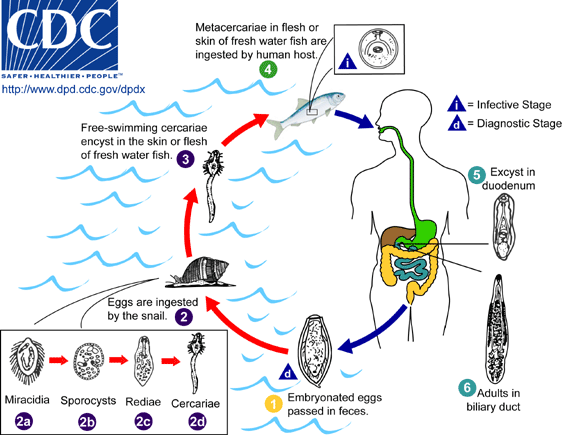Clonorchis is a liver fluke that can infect the liver, gallbladder and bile duct in humans. Found across parts of Asia, it is also known as the Chinese or oriental liver fluke. Humans become infected when eating the parasite containing cysts within infected raw or undercooked fish, crabs, or crayfish. Clonorchis can be treated by medication through your health professional.
Clonorchis is a liver fluke that can infect the liver, gallbladder and bile duct. Found across parts of Asia, it is also known as the Chinese or oriental liver fluke.
The eggs of Clonorchis sinensis are ingested by a snails in fresh water. After the eggs hatch, infected snails will release microscopic larvae that will enter freshwater fish. People become infected when eating the parasite containing cysts within infected raw or undercooked fish. Once ingested, cysts travel to the small intestine and liver where they feed upon the bile created by the liver and mature. The life cycle takes 3 months to complete in humans. Infected people will then pass eggs in their feces or may cough them up.
Chlonorchis is found in Asia including Korea, China, Taiwan, Vietnam, Japan, and Asian Russia. When clonorchiasis has been reported in non-endemic areas, the infection was found in Asian immigrants. Some cases were found in people who had ingested imported, undercooked or, pickled freshwater fish containing parasitic cysts.
See your health care provider if you think you may have been exposed to Clonorchis.
The detection of eggs in stool is the most common way to diagnose the infection. Sometimes an endoscopy is done to examine the small intestine for eggs. Additionally, ultrasound, CT, and MRI scanning may be used to discover parasite-containing cysts that contribute to a diagnosis.
No. Clonorchis cannot be directly transmitted from person to person.
Most signs and symptoms are related to inflammation and intermittent obstruction of the biliary ducts. In severe cases, abdominal pain, nausea, and diarrhea can occur. In long-standing, untreated infections, inflammation of the biliary system can lead to cancer, which can be fatal.
The trematode Clonorchis sinensis (Chinese or oriental liver fluke).

Embryonated eggs are discharged in the biliary ducts and in the stool. Eggs are ingested by a suitable snail intermediate host. Each egg releases a miracidia, which go through several developmental stages, and cercariae. The cercariae are released from the snail and after a short period of free-swimming time in water, they come in contact and penetrate the flesh of freshwater fish, where they encyst as metacercariae. Infection of humans occurs by ingestion of undercooked, salted, pickled, or smoked freshwater fish. After ingestion, the metacercariae excyst in the duodenum and ascend the biliary tract through the ampulla of Vater. Maturation takes approximately 1 month. The adult flukes (measuring 10 to 25 mm by 3 to 5 mm) reside in small and medium sized biliary ducts. In addition to humans, carnivorous animals can serve as reservoir hosts.
Life cycle image and information courtesy of DPDx.
For more information view the source:Center for Disease Control
Recommended Test:Full GI Panel
Recommended Product:Freedom Cleanse Restore Parasite Cleanse